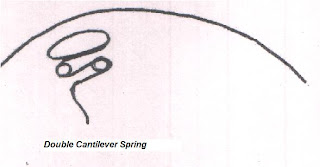Anterior cross bite
Possible causes
Class III skeletal pattern
Crowding
Retained primary teeth and roots
Presence of supernumerary teeth
Trauma
Clinical features
- Instanding maxillary incisor occluding behind the corresponding lower incisors.
- Over bite which can vary from nothing to excessive depth.
- Gingival recession of the lower incisor involved.
- Forward displacement of the mandible- instanding tooth comes into premature contact along the normal path of closure.
- mobility of the lower incisor involved in the cross bite.
Methods available for correction
Spoon handle biting.
Removable appliance with either cantilever spring or screw.
Lower inclined bite plane.
Spoon handle biting
Instruct the child to bite on a spoon handle to guide the incisor which is erupting into cross bite.
Do not attempt this on an erupted incisor which has a positive over bite.
Once cross bite established,
Identify predisposing factors and remove them to prevent development of the cross bite
Once the cross bite is established, identify and remove aetiological factors responsible and select appropriate method for correction.
Removable appliance
Selection of appliance and the spring design depend on,
Axial inclination of the tooth
Depth of the over bite.
Amount of forward movement required
Number of teeth involved in the cross bite
Appliance design
Select the best active component which should be used depending on the above factors discussed.
Adequate number of clasps
Add adequate number of clasps to the appliance to resist the reaction of the vertical component of the active force.
Appliance design
Add posterior bite plane to disocclude teeth
Instruction to the technician
Adams clasps on 6/6 d /d
Double cantilever spring(Z spring) on /1
Posterior bite plane (half molar capping)
Management of patient
Fit the appliance and give adequate instructions to the patient to wear it regularly including meal time.
Activate the spring by the correct amount.
Adjust clasps and check the thickness of the molar capping.
Give adequate instruction to the parents as well.
Monitor progress of treatment
If cross bite is corrected and depth of the over bite adequate to ensure the stability of the occlusion discontinue appliance
Monitor the development of the occlusion until the occlusion of the permanent dentition is established.
Incisors cross bite before and after correction
Incisor cross bite not corrected early lead to a severe malocclusion



























